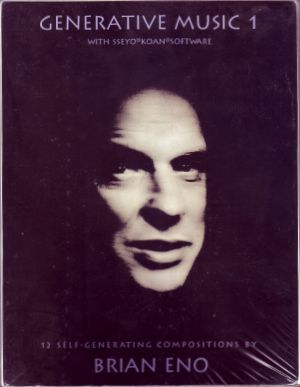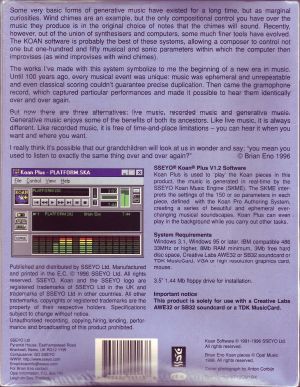Tap images for larger versions. Internet Wayback Machine »
Brian Eno's "Generative Music 1" was a landmark release published in 1996.
Brian Eno is undoubtedly a genius and polymath who, well before 1996, had already carved out a well deserved place in the history books across multiple fields of endeavour. So, we were very lucky and honoured indeed to have Eno use SSEYO Koan: what he did with it was incredible and it was a huge privilege to have spent some time with him. We will never forget that, his kindness or his achievements; it was a great coming together and we were in the right place at the right time.
It is all the more incredible when you realise that it was during the time he was working with SSEYO Koan that he coined the term 'Generative Music'.
Generative Music 1 was a floppy disk-only title published in 1996. Eno created its Koan pieces using SSEYO Koan Pro [now evolved to Wotja]. A specific soundcard was required to hear the music as he intended - without that soundcard the music sounded very different.
You can, however, hear a few snippets in "Dark Symphony" which features works from the huge Koan generative music software retrospective entitled “Floating Points im de KlangPark”, that was a 48 hour, 250,000-watt, public acoustic ambience exhibit presented at Ars Electronica’s 2003 “CODE – the Language of Our Time”. See: Dark Symphony (YouTube), Dark Symphony (Vimeo; with links to 5:1 AAC source files).
Generative Music Historians / Collectors
If we remember correctly, only one or two thousand were ever made, so if you bought or own a copy, and have kept it, you are a very lucky person indeed!
Eno collectors may hope that, even if only for posterity and to hear things as he intended, he does one day release a CD of audio recordings he made (he sold a number of one off recordings on CD via White Cube).
Eno using the pseudonym CSJ Bofop, 1996:
"Each of the twelve pieces on Generative Music 1 has a distinctive character. There are, of course, the ambient works ranging from the dark, almost mournful Densities III (complete with distant bells), to translucent Lysis (Tungsten). These are contrasted with pieces in dramatically different styles, such as Komarek with its hard edged, angular melodies, reminiscent of Schoenberg's early serial experiments, and Klee 42 whose simple polyphony is similar to that of the early Renaissance. But of course, the great beauty of Generative Music is that those pieces will never sound quite that way again."
Box Front:
Generative Music 1
with SSEYO Koan Software
12 Self-Generating Compositions by
Brian Eno
Box Back:
Some very basic forms of generative music have existed for a long time, but as marginal curiosities. Wind chimes are an example, but the only compositional control you have over the music they produce is in the original choice of notes that the chimes will sound. Recently, however, out of the union of synthesisers and computers, some much finer tools have evolved. Koan Software is probably the best of these systems, allowing a composer to control not one, but one-hundred and fifty musical and sonic parameters, within which the computer then improvises (as wind improvises the wind chimes).
The works I have made with this system symbolise, to me, the beginning of a new era of music. Until a hundred years ago, every musical event was unique: music was ephemeral and unrepeatable, and even classical scoring couldn't guarantee precise duplication. Then came the gramophone record, which captured particular performances, and made it possible to hear them identically, over and over again.
But now, there are three alternatives: live music, recorded music, and generative music. Generative music enjoys some of the benefits of both its ancestors. Like live music, it is always different. Like recorded music, it is free of time-and-place limitations — you can hear it when and where you want.
I really think it is possible that our grandchildren will look at us in wonder and say: "You mean you used to listen to exactly the same thing over and over again?" © Brian Eno 1996.
Published and distributed by SSEYO Ltd. Manufactured and printed in the E.C. © 1996 SSEYO Ltd. All rights reserved. SSEYO, Koan and the SSEYO logo are registered trademarks of SSEYO Ltd. in the UK and trademarks of SSEYO Ltd. in other countries. All other trademarks, copyrights or registered trademarks are the property of their respective holders. Specifications subject to change without notice. Unauthorised recording, copying, hiring, lending, performance and broadcasting of this product prohibitied.
SSEYO Ltd, Pyramid House, Easthampstead Row, Bracknell, Berks, UK RG12 1YW. Compuserve: GO SSEYO. WWW: http://www.sseyo.com Email: koaninfo@sseyo.com For Brian Eno contact, Opal Information, P.O. Box 141, Leigh-on-Sea England.
SSEYO Koan Plus V1.2 Software
Koan Plus is used to 'play' the Koan pieces in this product, the music is generated in real-time by the SSEYO Koan Music Engine (SKME). The SKME interprets the settings of the 150 or so parameters in each piece, defined with the the SSEYO Koan Pro Authoring System, creating a series of beautiful and ever-changing musical soundscapes. Koan Plus can even play in the background while you carry out other tasks.
System Requirements
Windows 3.1, Windows 95 or later. IBM compatible 486 33MHz or higher, 8Mb RAM, 3Mb free hard disk space, Creative Labs AWE32 or SB32 soundcard or TDK MusicCard, VGA or high resolution graphics card, mouse.
3.5" 1.44Mb floppy drive for installation.
Important notice
This product is solely for use with a Creative Labs AWE32 or SB32 soundcard or TDK MusicCard.
Koan Software © 1991-1996 SSEYO Ltd. All rights reserved.
Brian Eno Koan pieces © Opal Music 1996. All rights reserved.
Cover photograph by Anton Corbijn
Part Number KP12GM1BX
Bar Code 7 69490 11113 8
SSEYO and Opal logos
Side:
Generative Music 1
Brian Eno
with SSEYO Koan Software
Opal
SSEYO
Inside:
Opal Pamphlet
Floppy Disk containing the SSEYO Koan Plus V1.2 Software and the following Koan pieces:
- Densities III
- Klee 4.2
- Komarek
- Lysis (Tungsten)
- Methane IV
- Microcosmology
- NS-9001
- Platform 292
- Rothko Doric
- Seed Reflector
- Supporting Circle
- Tintoretto

